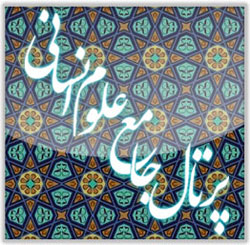بررسی تطبیقی وحدت شهود و وحدت وجود در جامجم اوحدی، گلشن راز شبستری و اسرارالشهود اسیری لاهیجی
کلمات کلیدی:
وحدت وجود, وحدت شهود, انسان کامل, اوحدی مراغهای, شبستری, اسیری لاهیجیچکیده
از مباحث اصلی در سیر تحول زبان و اندیشه عرفان اسلامی، دیدگاه شهودی و وجودی عارفان اسلامی است که بهطور گسترده در آثار عارفان و صوفیان مورد توجه قرار گرفتهاند. از نظر متصوفه، وحدت شهود، ادراک توحید الهی و اثبات آن است. در این دیدگاه، توحید الهی تنها از طریق کشف و شهود سالک اثبات میشود. پیروان وحدت شهود، ذات حق تعالی را مبرا از هر مثل و مانند میدانند، در نگاهی دیگر متابعان وحدت وجود، جز وجود که عینیت با ذات الهی دارد، چیزی را واقعی و حقیقی نمیدانند. اوحدالدین مراغهای عارف اواخر قرن هفتم و اوائل قرن هشتم است. وی در منظومۀ جام جم به ویژگیهای انسان پرداخته است. هدف از پژوهش حاضر بررسی منظر شهودی اوحدی مراغهای در مطابقت با دیدگاه وجودی شیخ محمود شبستری در منظومه گلشن راز و اسیری لاهیجی در منظومه اسرارالشهود است که به شیوه توصیفی - تحلیلی صورت میپذیرد. اوحدی مراغهای بر"وحدت شهود" تأکید دارد که در آن سالک از طریق کشف و شهود، به فناء در حقیقت واحد میرسد. در مقابل، شبستری و اسیری لاهیجی در آثار خود به "وحدت وجود" پرداختهاند و معتقدند که تمام موجودات تجلیات یک حقیقت واحد، یعنی خداوند، هستند. این تحقیق بیانگر آن است که در آثار این عارفان، تأکید بر یگانگی حقیقت و تجلیات الهی و نفی دوگانگیهای موجود در عالم هستی وجود دارد.
دانلودها
مراجع
1. Servatiyan B. Simple Commentary on Golshan-e Raz: Tehran: International Publishing Company; 2017.
2. Mohammadi Bagmalaei MK. Hadith Bi-Kam wa Bish (Sharh Golshan-e Raz by Sheikh Mahmoud Shabestari): Qom: Parsian Publishing; 2000.
3. Asiri Lahiji SM. Asrar al-Shuhud: Tehran: Human Sciences and Cultural Studies Institute; 1989.
4. Mahmoudian H. Unity of existence and unity of witness in Islamic mysticism: Conceptualization and its background. Islamic Mysticism Journal (Religions and Mysticism). 2009;5(20):37-67.
5. Elahi Ardabili HBA. Sharh Golshan-e Raz: Tehran: University Publishing Center; 1997.
6. Akhlaghi M. Unity of existence and unity of witness. Sina Wisdom Quarterly. 2004;26-27:86-111.
7. Lahiji SM. Mafatih al-I'jaz fi Sharh Golshan-e Raz: Tehran: Zavar Publishing; 2016.
8. Rahimian S. Foundations of Theoretical Mysticism: Tehran: Samt Publishing; 2009.
9. Khani Habib Abadi A, Nourian M, Agha Hosseini H. The mystical approach of Owdi Maraghei. Researches in Mystical Literature (Gohar-e Goya). 2019;13(Spring 1398):39-64.
10. Owhadi Maraghei Isfahani O. Jam-e Jam: Tehran: Ferdowsi Printing House; 1928.
11. Mostamli Bukhari IBM. Sharh al-Ta'aruf li Mazaheb al-Ta'aruf: Tehran: Asatir Publishing; 1987.
12. Qushayri ABH. Risalah Qushayriyyah: Tehran: Scientific and Cultural Publishing Company; 1995.
13. Nekunam MR. The Journey of Thought: Qom: Zohour Shafaq; 2007.
14. Shabestari SM. Golshan-e Raz: Tehran: Tahouri; 1989.
15. Jondi M. Sharh Fusus al-Hikam: Mashhad: University of Mashhad; 1982.
16. Da'i Shirazi SM. Nasayem Golshan: Tehran: Elham Publishing; 1998.
17. Kamal Khwarazmi HBH. Sharh Fusus al-Hikam by Muhyi al-Din Ibn Arabi: Tehran: Mowlavi Publishing; 1985.
18. Ibn Arabi MBA. The Perfect Human: Tehran: Jami; 2007.
19. Ibn Arabi MBA. The Letters of Ibn Arabi: Tehran: Mowlavi Publishing; 2014.
20. Qaysari DBM. Sharh Fusus al-Hikam: Tehran: Scientific and Cultural Publishing; 1996.
21. Torkeh Isfahani SAM. Al-Tamhid al-Qawa'id: Tehran: Bustan Ketab; 1981.








